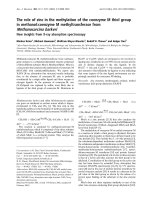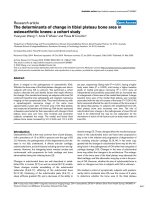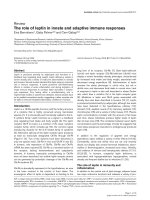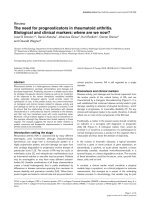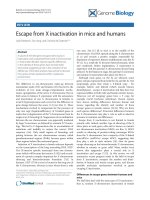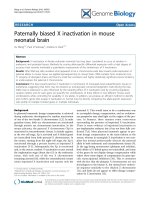Báo cáo y học: "The reported thoracic injuries in Homer’s Iliad" potx
Bạn đang xem bản rút gọn của tài liệu. Xem và tải ngay bản đầy đủ của tài liệu tại đây (1.08 MB, 9 trang )
REVIEW Open Access
The reported thoracic injuries in Homer’s Iliad
Efstratios Apostolakis
1*
, Georgia Apostolaki
2
, Mary Apostolaki
3
, Maria Chorti
4
Abstract
Homer’s Iliad is considered to be a prominent and representative work of the tradition of the ancient Greek epic
poetry. In this poem Homer presents the battles which took place during the last year of the 10-year lasting Trojan
War between Achaeans and Trojans. We wanted to examine the chest wounds, especially those which are
described in detail, according to their localization, severity and mortality. Final ly, there are reported 54 consecutive
thoracic injuries in the Iliad. The mostly used weapons were the spear (63%), the stones (7.4%), the arrow (5.5%)
and the sword (5.5%). We divided the injuries according to their severity in mild (those which did not cause ser-
ious injury to the victim), medium (those which cause the victim to abandon the battlefield), and severe (those
which cause death of the victim). According to this classification, the reported injuries were mild in 11.11%, med-
ium in 18.52%, and severe in the last 70.37% of the reported cases. In other words, 89% of the injuries belong to
the medium or sev ere category of thoracic injury. As far as the mortality of the injuries is concerned, 38 out of 54
thoracic injuries include death, which makes the mortality percentage reach 70.37%. Concerning the “allocation of
the roles”, the Achaean were in 68% perpetrators and the Trojans in only 32%. In terms of gravity, out of 38 mortal
injuries 30 involve a Trojan (78.95%) and the remaining 8 an Achaean (21.05%). The excellent and detailed descrip-
tion of the injuries by Homer, as well as of the symptoms, may reveal a man with knowledge of anatomy and
medicine who cared for the injured warriors in the battlefield.
Introduction
“ while fighting Idomeneus stabbed at the middle of his
chest with the spear, and broke the bronze armour about
him which in time before had guarded his body from
destruction. He cried out then, a great cry, broken, the
spear in him, and fell, thunderously, and the spear in his
heart was struck fast but the heart was panting still and
beating to shake the butt end of the spear.Thenand
there Ares the huge took his life away from him ” (Book
13, verses 438-444) [1]
The “Iliad” and “Odyssey” of Homer are the founda-
tion stones of classical Greek literature, and therefore
also of the literature of Western civilization. Homer was
read,memorizedandquotedthroughoutthegreatage
of ancient Greece, and was regarded as the poet who
surpassed all others [2]. The Iliad and the Odyssey com-
prise two of the most important works of classical
Greek literature and they have in fluenced, to a great
extent, Western literature. The Iliad, in particular, is
considered to be a prominent and representative work
of the tradition of the ancient Greek epic poetry. By
means of a vivid, unsurpassed description of the war of
Troy the poet presents the battles which took place dur-
ing the last year of this 10-year war (figure 1). In an
ambient of insufferable impatience-or even despair-as
well as nostalgia for their country, the Trojans faced the
Achaeans, the former being exhausted due to the long-
lasting siege of the latter. Ho mer offers the description
of a merciless and rabid combat that leads t o the
destructive, on the part of the Trojans, ending. The
poem unravels the story of a war which proves to be a
vacillating and inexpedient conflict.
AccordingtoMumfordD[2],anger,wrath,aggres-
sion, fear and panic constitute the psychological state
which characterizes the heroes of Iliad. In this tragically
drawn picture, people and Gods are brought into con-
flict, obeying, however, the rules of an earthly “ war
game” , using namely human weapons of the era, so that
both humans and gods would be equal opponents fol-
lowingthesamerulesoftheartofwar.Aroundthe
bloodshed walls o f Troy lethal combats took place,
involving hand-to-hand conflicts (b. 2, v. 265-270), (b. 4,
v. 134-140), (b. 4, v. 473-488), (b. 5, v. 38-42), (b. 5, v.
79-83), (b. 7, v. 318-322), (b. 8, v. 219-225), (b. 8, v.
* Correspondence:
1
Department of Cardiothoracic Surgery. Patras University School of Medicine,
Patras, Greece
Full list of author information is available at the end of the article
Apostolakis et al. Journal of Cardiothoracic Surgery 2010, 5:114
/>© 2010 Apostolakis et al; licensee BioMed Central Ltd. T his is an Open Access arti cle dist ributed under the t erms of the Creative
Commons Attribution License ( which perm its unrestricted use, distribution, and
reproduction in any medium, provided the original work is properly cited.
268-272), (b. 9, v. 320-329), (b. 11, v. 76 -79), (b. 12, v.
15-46), (b. 14, v. 264-265), (b. 21, v. 116-120) [1]. The
arms used in these battles were “low-energy” ones, as
they are commonly known: arrows, lances, jave lins,
stones, and bludgeons [3-6]. This meant that the
wounds were, in general, non-lethal and the injured
usually survived their wounds or, at least, lived for a
long time after the injury. Co nsequently, the wo und was
“accessible” to their comrade-in-arms and thus the latter
could observe and offer a detailed description of it (b. 5,
v. 95-100), (b. 5, v. 79-83), (b. 8, v. 257-260), (b. 8, v.
300-308), (b. 11, v. 446-449), (b. 13, v. 437-444), (b. 13,
v. 595-600), (b. 15, v. 541-543) [1]. It must have been
similarly easy for a skilful writer, such as Homer, to pro-
duce extensive descriptions of these wounds. Indeed, the
Iliad abounds with such descripti ons of wounds of all
kinds, ranging from light to instantaneously fatal ones.
The latter involve mainly injuries to the head and the
torso, and more particularly the chest [3]. This study
will focus on the descriptions which especially involve
chest injuries caused during the Trojan War. It goes
without saying that in such a war there would be thou-
sands of wounds. What would be of interest here is to
examine the chest wounds, especially those which are
described in detail, be it the wound of a prominent war
hero (“ Afterwards with Erymas, Amphoteros, and
Epaltes, Tlepolemos Damastor’ sson,EchiosandPyris,
Ipheus and Euippos, and Argeas’ son Polymelos, all
these he felled to the bountiful earth in rapid succes-
sion”) (b. 16, v. 415-418) [1] or that of an inconspicuous
victim.
Materials and methods
In order to discern the diverse injuries mentioned in the
Iliad, a meticulous reading of the whole poem is neces-
sary although in some rhapsodies (boo ks in English
translation) -1, 3, 9, 18, 19, and 24- there is no reference
to injuries. These rhapsodies include the events which
occurred during the “intermissions” of the war. Other
rhapsodies, for instance 5, 13, 16 or 12 are characterized
as “ the most let hal ones” (see additional file 1). For
most of the reported injuries there is a reference not
only to the method used by the perpetrator to injure
his/her victim or the area where the injury occurred but
also to ot her factors, such a s the place of origin of the
victim and the perpetrator, the nature of the weapon
which caused the injury and the outcome o f the conflict
(b.2,v.265-270),(b.4,v.134-140),(b.4,v.527-531),(b.
5, v. 17-24), (b. 5, v. 38-42), (b. 5, 55-58), (5, 95-100),
(b. 8, v. 300-308), (b. 8, v. 320-v. 329), (b. 11, v. 43 4-438),
(b. 11, v. 446-449), (b. 21, v. 116-120) [1]. Limiting the
survey to the sole description of the injuries viewed
Figure 1 Amphora representing a lethal battle between the Achaeans and the Tro jans over Patroclus’ dead body. The Trojans,
presented on the left side, have already despoiled Achilles’ famous attire, which Patroclus was wearing, but eventually the Achaeans, presented
on the right, claim the corpse. (black-figure drinking cup dated 500 BC, Archaeological Museum of Munich).
Apostolakis et al. Journal of Cardiothoracic Surgery 2010, 5:114
/>Page 2 of 9
merely as medical cases would definitely undermine the
work of this skilful poet. Therefore, in the last column of
the table above whole passages from the original text are
quoted so that the reader can relish the vivid descriptions
of unique beauty as presented by the poet himself.
Concerning the estimation of the gravity and mortality
of the thoracic injuries, there is great di fficulty either
because there is a lack of medical details or because of
the lack of continuity in the description of the injury.
Homer seldom includes a reference to the therapy fol-
lowing the inj ury, as in cases 11 and 15. Only in cases
of lethal wounds can we infer that the injury was grave.
In this survey the injuries are arbitrarily categorized
according to a three-level scale: “mild injuries” or “(+)”
are those which did not cause serious injury to the war-
rior and so he could return to the battlefield. “Severe
injuries” or “(+++)” are those which cause the victim
to fall on the ground. In all these injuries the victim
dies instantly. Finally, “medium injuries” or “(++)” are
those which cause the victim to abandon the battlefield
without causing death.
Results
Injuries according to rhapsodies
From a total of 151 injuries, 54 are injur ies of the chest
(35, 76%) (See additional file 1). Santos G [3] includes a
much smaller percentage in his survey (20%) since the
survey mentions 26 chest injuries out of 1 30. The 54
injuries mentioned in our survey include 53 warriors
and two of them involved the same warrior, Diomedes
(cases 11 and 13 in additional file 1). Most of the inju-
ries can be found in rhapsody 5 (11 injuries) and then
follow rhapsody 16 (7 injuries), rhapsody 11 (6 injuries),
rhapsodies 7 and 15 (5 injuries), rhapsodies 4 and 13 (4
injuries), rhapsody 21 (3 injuries), rhapsodies 7, 14, 17
and 20 (2 injuries), and, rhapsody 2 (1 injury).
Victimizers or perpetrators and victims
The directness of Homer’s language transforms Gods
into creatures of this earth and renders the heroes brave
or even arrogant. By means of the skilful use of language
Homer manages to place the two opponents, the Gods
and the mortals, on an equal level in the field of battle:
both groups share the same passions. They feel hatred,
loveandwhattheydesireistoavengethemselvesorto
win the battle and, consequently, they confront each
other with incredible vehemence. From a total of 54
thoracic i njuries, 50 include those between two mortals
whereas the rest of them are the result of a conflict
between two Gods or a God and a mortal. Indeed, in
two cases (cases 14 and 15) one semi-God, son of Zeus,
Amphitrionades, attacks Hera and Hades. In addition, in
cases 53 and 54, Goddess Athena attacks the God of
war, Ares, as well as the Godd ess of Beauty, Aphrodite.
The Gods’ partiality fo r one hero or another was often
demonstrated by means of their intervention in the field
of battle. A singular example is case 47 (b. 16, v. 791-
809) [1], where Apollo strips brave Patroclus of h is
armour during the battle and, thus, Euphorbus the
Trojan manages to strike the latter in the interscapular
area. Consequently, Hector exploits Patroclus’ vulner-
ability and strikes him in the in guinal area wh ich causes
Patroclus to die (b.16, v. 818-822) [1]. (Figure 2).
Perpetrator-victim or Homer’s “partiality”
Homer’ s partiality is made apparent in the poem
although the reader may expect an impartial presentation
oftheevents.Thepoetconstantlytendstopraisethe
Achaeans’ superiority over the Trojans. How else can the
analogy between the perpetrators and the victims be
explained? One could argue that the Achaean perpetra-
tors excelled in number the Trojan perpetrators only
during the last year of the war and this is the reason why
Homer’s description is “partial”. In the epic, the perpetra-
tor was an Achaean in 34 cases and a Trojan in 16 cases.
In 4 cases the perpetrator was a God or a semi-God.
Concerning the victims, 35 of them were Trojans, 15
were Achaeans and 4 were Gods or semi-Gods.
Weapons used
There is a wide variety of weapon mentioned in the
conflicts, ranging from spears to stones or even the
scepter of Odysseus, king of Ithaca. The use of the spear
is mentioned in 34 cases of the thoracic injuries
(62.96%). The use of the arrow is the second most
important weapon which is mentioned in three cases
(5.55%), the stone is mentioned in 4 cases (7.40%), the
sword in three cases (5.55%), the javelin as well as the
sword in two cases (3.70%) and, finally, the hand a nd
the scepter in one case (1.85%) (b. 2, v. 265-270) [1].
Localization of the thoracic injuries
Detecting and analyzing the injuries is a difficult task
since their description is not always precisely reported.
Most of the injuries to the back are referred to as
“ metaphrenon” without mentioning whether they
occurred in the interscapular area or at the basis of
thethorax(seetable).Moreover,insomeoftheinju-
ries of the upper thorax it is difficult to distinguish
between those of the thorax and those of the neck.
Some of the injuries, for instance thos e of the shoulder
or the arm, may be categorized as injuries of the
thorax since the result of the attack was instant death.
The same categorization may also be applied to some
of the injuries of the hip or the pelvis. Another diffi-
culty is that some injuries combine two different areas
of the body: 3 of them include the thorax and the
abdomen (cases 5, 18, 32), two of them appear in the
Apostolakis et al. Journal of Cardiothoracic Surgery 2010, 5:114
/>Page 3 of 9
thorax and the shoulder (cases 33 and 38), two injuries
include the thorax and the neck (cases 23 and 34) and
one includes the thorax and the head (case 26) (see
additional file 1). Unfortunately, out of the 46 injuries
which relate to the thorax there is a lack of informa-
tion for 9 injuries (cases 2, 3, 13, 21, 25, 27, 30, 36 and
54 of the additional file 1) and, consequently, their
categorization in one of the subcategories in table is
rendered difficult. The 37 injuries which remain can be
categorized in relation to the area of the body in which
they appear in the table.
The gravity and mortality of the thoracic injuries
According to the aforementioned evaluation of injuries
(see “Material and Methods” ), the 54 thoracic injuries
mentioned in Homer’s work can be categorized as
follows:
a. Mild or (+) : 6 cases (11.11%) (The cases 1, 6, 18,
34, 53, 54 of the additional file 1)
b. Medium or (++): 10 cases (18.52%) (The cases 2,
11, 13, 14, 15, 23, 27, 29, 47, 49 of the additional file 1)
c. Severe or (+++): 38 cases (70.37%) (the cases 3, 4,
5, 7, 8, 9, 10, 12, 16, 17, 19, 20, 21, 22, 24, 25, 26, 28,30,
31, 32, 33, 35, 36, 37, 38, 39, 40, 41, 42, 43, 44, 45, 46,
48, 50, 51, 52 of the additional file 1).
As it is shown in the categories above (see “Material
and Methods”), 89% of the injuries belong to the med-
ium or severe category of thoracic injury. As far as the
mortality of the injuries is concerned, 38 out of 54 thor-
acic injuries include death, which makes the mortality
percentage reach 70.37%. It should be noted that all ser-
ious injuries which result in death are cases of “instant
mortality”. If we were to divide the mortality of the inju-
ries according to the tribe, the conclusion would be that
the Trojans had far more casualties than the Achaeans.
Of course, out of the 54 injuri es we would have to omit
4 (cases 14, 15, 53, 54) since they involve Gods. Out of
the remaining 50, only 16 or 32% of injuries involve a
Trojan perpetrator, while the majority (34 cases or 68%)
involves an Achaean one. In terms of gravity, o ut of 38
mortal injuries 30 involve a Trojan (78.95%) and the
remaining 8 and Achaean (21.05%). On the contrary, in
Figure 2 Amphora dated 610 BC, Archaeological Museum of London . Menelaus and Hector’s combat over Euphorbus’ body. The latter, the
son of the priest of Apollo Panthos, had wounded Patroclus in his back and then Hector stroke Euphorbus in the chest.
Apostolakis et al. Journal of Cardiothoracic Surgery 2010, 5:114
/>Page 4 of 9
12 non-mortal injuries ("light” or “medium” )aTrojan
perpetrator appears in 8 cases (66.66%) while an
Achaean attacker is mentioned in on ly four (33.33%).
Therefore, it can be inferred that although Homer
attempts to present the two sides as equally powerful,
he rather gives a biased report of the incidents of the
War. There are many reasons attributed; firstly, the
majority of the Olympian Gods were supporting the
Achaeans and they used all means possible to demon-
strate their preference. Athena (b. 5, v. 836-837), ( b. 8,
v. 358-363), (b. 10, v. 48 2-487), (b. 11, v. 10-12), (b. 15,
v. 68-70 and 211-217), Hera (b. 5, v. 784-791), ( b. 8, v.
352-356), (b. 15, v. 211-217), Poseidon (b. 15, v.
211-217), Hermes (b. 15, v. 211-217) and Hephaestus (b.
15, v. 211-217) side with the Achaeans (b. 20, v. 33-37)
[1]. On the contrary, Zeus (b. 8, v. 352-356), (b. 11, v.
78-79),(b.15,v.14-17,v.68-70,v.228-235,and
v. 254-255), Apollo (b. 7, v. 272), (b. 15, v. 228-235 and
v. 254-255), Ares (b. 5, v. 845-860), Aphrodite (b. 5, v.
376-378), Leto and Artemis support the Trojans (b. 20,
v. 38-40) [1]. Eris is the only Goddess who does not
support any of the two enemies since her only preoccu-
pation is to observe the battlefield. ( "And Hate [7], the
Lady of Sorrow, was gladdened to watch them. She
alone of all the i mmortals attended this action but the
other immortals were not there, but sat quietly remote
and apart in their palaces, where for each one of them a
house had been built in splendor along the folds of
Olympos” (b. 11, v. 73-77) [1]. Secondly, Homer’s Gr eek
origin renders him a biased judge of the war. Finally,
the Achaeans were trained to become the best warriors
and they were famous for their martial skills due to
the wars which often broke out among the different
cities of Greece.
Therapeutic interventions concerning the
aforementioned injuries
It goes without saying that in a large-scale campaign like
the one organized by the Achaeans the presence of doc-
tors would have been more than necessary. Indeed, two
of Asklepios’ sons, Mahaon and Podaleirios, are referred
to by the poet as doctors who participated in the cam-
paign (figure 3) . They a lso fought in the battlefield (b.
11, v. 8 36) [1]. In 4 cases of thoracic injuries there is a
therapeutic or medical intervention. In case 2 (b. 4, v.
134-140) [1] Pandarus’ arrow injures Men elaus. Venous
blood g ushes out of his thoracic wound ("from the cut
there gushed a cloud of dark blood” (b.4,v.140)[1]
and it is running on his thighs and calf and reached his
ankles ("so, Menelaos, your shapely thighs were stained
with the colour of blood, and your legs also and the
ankles beneath them” )(figure4)(b.4,v.146-147)[1]
and Agamemnon panics. He orders that they find
Mahaon, son of Asklepios, who seems to have been a
skilled doctor so that he could remove the arrow and
use herbs which will alleviate the pain. ("But the physi-
cian will handle the wound and apply over it healing sal-
ves, by which he can put an end to the black pains”) (b. 4,
v. 190-191) [1]. This also demonstrates that Agamemnon
wasawareofthetherapeuticproceduretobefollowed.
Indeed, Mahaon first removed the arrow from the thorax
and then from the flesh, which was profoundly wounded,
and then he draw blood from the wound so that the
venom would not enter his body. Finally, he placed thera-
peutic herbs over the wound, the ones which wise
Cheiron had taught his father to use (b. 4, v. 213-219) [1]
(figure 4). It seems that Mahaon himself was injured at
some point since he was in the battlefield and fought
while the battle was taking place. In case 29 (table 1)
Mahaon was hit by Paris with an arrow on his right
shoulder and was forced to stay outside the battlefield
(b. 11, v. 505-507) [1]. The Achaeans decided to cease
their charge because of their fear that Mahaon will fall
into the hands of the Trojans. (b. 11, v. 508-509) [1] Ido-
meneus called Nestor to lead the doctor a way from the
batt lefiel d to the ships (b. 11, v. 511-513) [1]. Even in the
heat of the battle Idomeneus does not hesitate to praise
Mahaon for his therapeutic methods since the latter can
remove the arrows and use the appropriate medicines
("A healer is a man worth many men in his knowledge of
cutting out arrows and putting kindly medicines on
wounds”) (b. 11, v. 514-515) [1]. In the same rhapsody
and towards the end of it there is another reference to
Mahaon’sinjuryaswellastothatofhisbrother,Poda-
leirios. Eurypylos is injured in his thigh with an arrow
and he begs Patroclus to bring him into his tent so that
the latter can heal him. Patroclus was taught how to heal
by Achilles and since both Mahaon and Podaleirios are
not available, he is the only one who can help Eurypylos.
("But help save me now at least, leading me away to my
black ship, and cut the arrow out of my thigh, wash the
dark blood running out of it with warm water, and put
kind medicines on it, good ones, which they say you have
been told of by Achilles, since Cheiron, most righteous of
the Centaurs, told him about them. As for Machaon and
Podaleirios, who were healers [ 3], I think Machaon has
got a wound, and is in the shelters lying there, and him-
self is in need of a blameless healer, while the other in
the plain is standing the bitter attack of the Trojans”)
(b. 11, v. 827-835) [1]. Homer describes the removal of
the arrow from his thigh with Patroclus’ knife, the conse-
quent administration of medicines and the nursing of the
wound (b. 11, v. 842-848) [1].
The third reference to an injury which receiv ed medi-
cal care was the one which was caused by Amphitryo-
niades (Zeus’ illegitimate son) with an arrow which he
threw against Hades in front of the gates of the dead
(b. 5, v. 394-397) [1]. Hades resorted to Zeus and, in the
Apostolakis et al. Journal of Cardiothoracic Surgery 2010, 5:114
/>Page 5 of 9
end,hiswoundwastreatedby Paieon with the use of
medicines from Olympos (b. 5, v. 401-2 and v. 889-890)
[1]. Finally, in case 11 Pandarus’ arrow is struck in Dio-
medes’ right shoulder. The arrow penetrates his chest
(we can infer that it went across the thoracic wall) and
it goes out on the other side filling the chest with blood
(b. 5, v. 98-100) [1]. Then Diomedes asked Sthenelos to
remove the arrow (b. 5, v. 109-110) [1]. Indeed, Sthene-
los dismounted from his chariot and pulled the arrow
from his chest. It appears that the arrow had been firmly
fixed in his chest since, when Sthenelos removed it,
blood gushed from the wound and stained his tunic
(b. 5, v. 111-113) [1] (figure 5).
Discussion-Hypotheses
Homer’s skillfulness and his unique talent in the narra-
tion of the events of the Trojan War are made prevalent
in this epic poem. Who coul d present us with a more
vivid picture of the mourning of Achilles’ horses because
of Patroclus’ death? ("But the horses if Aiakides standing
apart from the battle wept, as they had done since they
heard how their charioteer had fallen in the dust at the
Figure 3 Doctor Mahaon nurses the wound of Menelaus extracting the arrow from his chest (chalcography, F. Nenci, 1837).
Apostolakis et al. Journal of Cardiothoracic Surgery 2010, 5:114
/>Page 6 of 9
hands of murderous Hektor (b. 17, v. 426-428) [1]. A
blind man could not have offered such a detailed
description of hunting or agricultural life in general :
(b. 2, v. 467-471), (b. 11, v. 474-481), (b. 11, v. 548-555),
(b. 12, v. 146-152), (b. 13, v. 471-4 75), (b. 13, v. 588-
590), (b. 15, v. 630-636), (b. 16, v. 130-141), (b. 17, v.
657-664), (b. 18, v. 22-27) [1].
In addition, the detailed description, the detection and
the symptoms of the injuries may reveal a man with
knowledge of “ anatomy” ,aswellas“ physiology”
[2,7- 10]. The detailed descriptions of t he Greek doctors’
interventions may demonstrate that Homer did not only
have a good command of “anatomy” but he also had
knowledge of “medicine” and was closely associated with
the battlefield.
A plethora of medical terms, such as thumos (heart)
(433 times), phrenes (chest or diaphragm) (176 times),
hypochondrium (12 times), head or cranium (71 times),
brain (7 times), intestines (5 times), liver (6 times) etc
Figure 4 Sthenelos nurses Diomedes’ wound. In this representation on an amphora of Chalkida (550 BC), the wound can be detected on the
hand and not on the chest, as described in the original text. (b. 5, v. 111-113) [1].
Table 1 The localization of the injuries of the chest
according to their description (37 out of 46 injuries)
Area of the thorax Nr of case from table 1 total
shoulder 8, 10, 11, 15, 17, 29, 35, 42, 43, 49 10
Interscapular area 1, 7, 9, 20, 28, 47, 50, 51, 53 9
breast 4, 12, 14, 19, 22, 24, 39 7
sternum 6, 37, 40, 41, 44, 46 6
clavicle 16, 48, 52 3
precordial area 31, 45 2
Apostolakis et al. Journal of Cardiothoracic Surgery 2010, 5:114
/>Page 7 of 9
reinforce the idea that Homer was a knowledgeable poet
[2]. There are at least 150 refe rences to anatomical
terms, mainly referring to topographic anatomy It is
unlikely that a blind poet would have been able to
describe the injuries using medical t erms without being
aware of their meaning. It may therefore be inferred
that Homer was a witness of the war and that he ev en
participated in it: he may have been one of the people
appointed to n urse the wounds of the injured warrio rs
[8-22].
Additional material
Additional file 1: The 54 thoracic injuries are presented as they are
referred to in the book and the lines in which they are found and
then follow the name of the perpetrator, of the victim, the area
which was injured as well as the outcome. The severity of the injury is
presented as (+), (++), or (+++) corresponding to mild, medium or
severe injuries. In the last column passages from the original text are
quoted and some interesting comments accompanied these parts (A =
Achaean, T = Trojans, b. = book, v. = verse).
Author details
1
Department of Cardiothoracic Surgery. Patras University School of Medicine,
Patras, Greece.
2
English Literature. University of Athens. Athens, Greece.
3
Pedagogic Literature. University of Athens. Athens, Greece.
4
Department of
Pathology. ‘’Sismanogleio’’ General Hospital of Athens. Athens, Greece.
Authors’ contributions
EA: wrote, correct and revised the manuscript. GA: translate, and revised
English version. MA: did the bibliographic research found the figures. MC:
did the bibliographic research and designs the manuscript. All authors read
and approved the final manuscript.
Competing interests
The authors declare that they have no competing interests.
Received: 1 July 2010 Accepted: 19 November 2010
Published: 19 November 2010
References
1. Lattimore , Richmond : The Iliad, translation. Chicago and London: The
University of Chicago Press; 1951.
2. Mumford D: Somatic symptoms and psychological distress in the Iliad of
Homer. J Psychosomatic Research 1996, 41:139-48.
3. Santos GH: Chest trauma during the battle of Troy: ancient warfare and
chest trauma. Ann Thorac Surg 2000, 69:1285-87.
4. Polylas I: Homer’s Iliad [Greek edition]. Athens: Publishing Organization for
Educational Material, 4 1975, Regatos G: The war’s injuries in Iliad, pages:
κε’-νγ’.
5. Sapounakis C, Rallis G, Mourouzis C, Konsolaki E, Tesseromatis C: Injuries to
the head and neck in Homer’s Iliad. British Journal of Oral and Maxillofacial
Surgery 2007, 45:112-15.
6. Froehlich H: Die Militaermedizin Homer’s (The military medicine of Homer) [in
German] Stuttgart: Enke; 1879, 56-60.
7. Lattimore’s translation refers to Eris-as her original ancient Greek name
was-as Hate (b. 11, v. 73-77). .
8. Pikoulis E, Petropoulos J, Tsigris C, Pikoulis N, Leppaniemi A, Pavlakis E,
Gavrielatou E, Burris D, Bastounis E, Rich N: Trauma management in
ancient Greece: value of surgical principles through the years. World J
Surg 2004, 28:425-30.
9. Pollak Kurt: Die Heilkunde der Antike: Griechenland-Rom-Byzanz. Die
Medizin in Bibel und Talmud. Econ Verlag GmbH 1969 Dusseldorf und Wien,
Lizenzausgabe fuer R. Loewit; 1978, Wiesbaden.
10. Godquin B: Homere etait-il chirurgien? (Was Homer a surgeon?). Chirurgie
1990, 116:136-43.
11. Mylonas A, Tzervos F, Eftychiadis A, Papadopoulou E: Cranio-maxillofacial
injuries in Homer’s Iliad. Journal of Cranio-Maxillofacial Surgery 2008, 36:1-7.
12. Rutkow IM: The classical world [chapter 3]. In Surgery: an illustrated history.
Edited by: Rutkow IM. St. Louis, Missouri: Mosby-Year Book Inc; 1993:20-21.
13. Urso C: Anatomical references in Homer’s Iliad. Pathologica 1997,
89:26-30, (In Italian).
14. Sahlas DJ: Functional neuroanatomy in the pre-Hippocratic era:
observations from the Iliad of Homer. Neurosurgery
2001, 48:1352-57.
15. Grmek MD: Diseases in the ancient Greek world. Baltimore: Johns Hopkins
University Press; 1991.
16. Mylonas AI: Contemporary medical views aged 3000 years [in Greek].
Hellenic Arch Oral Maxillofac Surg 2003, 4:53-64.
17. Hollaus P: Military medicine in ancient Greece (Comment). Ann Thorac
Surg 2001, 72:1793.
18. Allison CE, Trunkey DD: Battlefield trauma, traumatic shock and
consequences: war-related advances in critical care. Crit Care Clin 2009,
25:31-45, vii.
19. Klimo P Jr, Ragel BT: Introduction: military neurosurgery, past and
present. Neurosurg Focus 2010, 28, Introduction.
20. Konsolaki E, Astyrakaki E, Stefanakis G, et al: Cranial trauma in ancient
Greece: From Homer to classical authors. J Craniomaxillofac Surg 2010.
21. Aydn A, Tumerdem B, Yazar M, et al: Three-thousand-year-old written
reference to a description of what might be the earliest brachial plexus
injuries in the Iliad of Homer. Plast Reconstr Surg 2004, 114:1352-3.
Figure 5 Homer’s image in marble (460 BC), Sculpture Museum
of Munich. The poet is represented as a blind man.
Apostolakis et al. Journal of Cardiothoracic Surgery 2010, 5:114
/>Page 8 of 9
22. Rubino M, Viale GL: The fatal wound of Hector, according to a drawing
by Peter Paul Rubens designed for tapestry weaving. Neurosurgery 2001,
48:406-11.
doi:10.1186/1749-8090-5-114
Cite this article as: Apostolakis et al.: The reported thoracic injuries in
Homer’s Iliad. Journal of Cardiothoracic Surgery 2010 5:114.
Submit your next manuscript to BioMed Central
and take full advantage of:
• Convenient online submission
• Thorough peer review
• No space constraints or color figure charges
• Immediate publication on acceptance
• Inclusion in PubMed, CAS, Scopus and Google Scholar
• Research which is freely available for redistribution
Submit your manuscript at
www.biomedcentral.com/submit
Apostolakis et al. Journal of Cardiothoracic Surgery 2010, 5:114
/>Page 9 of 9
